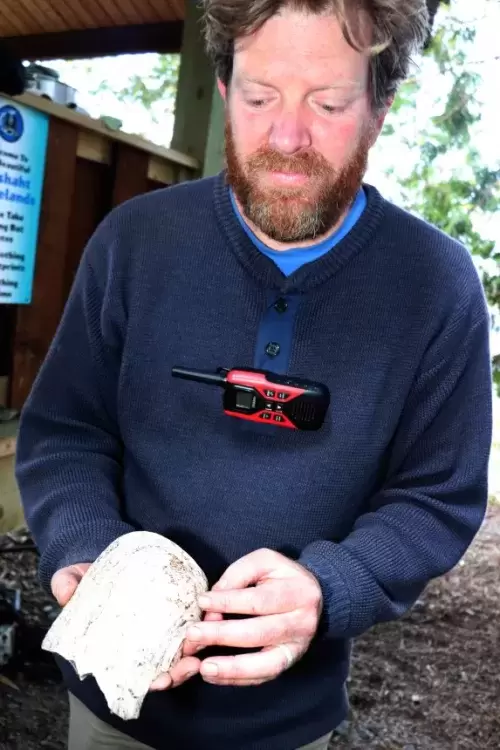Archaeologists working on Keith Island have made a significant discovery that proves Nuu-chah-nulth-aht ate geoduck clams prior to contact with Europeans.
Archaeologist and assistant professor Iain McKechnie said several shell fragments and a large, intact geoduck clam shell was found more than a meter deep in a pit on Keith Island, in Tseshaht territory, on July 13.
“To my knowledge this is the first time I've seen geoduck archaeological remains – we are confident that this is not a horse clam,” McKechnie stated.
He went on to say that this is the first find of this type in Nuu-chah-nulth territory and even on the coast of British Columbia.
“I am not aware of others,” he said.
Over the past three summers archaeology students unearthed thousands of artifacts on Keith Island, including a full set of bones from a woolly dog that is now extinct. The geoduck shells were found nearby, in a place that had been used continuously by Tseshaht for hundreds of years.
Archaeologist teams work at the site for two weeks each summer. This year is the third at Keith Island. The work is made possible through a partnership between the UVic Archaeology Field School, Parks Canada and Tseshaht First Nation.
McKechnie said the shells were located in a deposit that is at least 500 years old but could date back as much as 1,000 years.
“It was in a feature with other clams,” he said, adding that it appeared that the collection of shells may have been part of an ancient clam bake.
The shells appeared to be arranged purposefully and many intact shells were found with both sides of the shell aligned.
In addition, the shells in that layer of earth had evidence of oily residue inside the shells along with charred organic materials, like vegetation.
What this shows is that past generations of Tseshaht harvested these and more than 40 other species of shellfish, and brought them home for processing at this site, said McKechnie.
“This (dig site) contains a record of the people living here; it gives us information about the people living here, where they were going for food, what they are eating and how they harvested their food,” said McKechnie.
Denis St.Claire has been an archaeologist since 1970 and has close ties with Tseshaht First Nation, having consulted and formed friendships with elders early on in his career. He pointed to a long ridge that runs parallel to the beach, saying that it was a mulch pile made up of bones and shells that would have been outside the longhouses that were once there.
A few feet away lies a toppled tree, its roots studded with seashells hundreds of years old - shells that nurtured the tree until it fell.
There were pits on each side of the ridge, each about two meters square and just under two meters deep. The UVic archaeologists uncovered several generations of cooking hearths in one pit and even a shadowy impression left from a wooden house post.
The island was inhabited up until the 1950s so the top layers of soil contain items that came after contact, like metal nails and wood stove parts.
“This island contains both a past and current history,” said St. Claire.
The geoduck shells and other materials unearthed at Keith Island this summer will be sent to the University for analysis.
Tseshaht Councilor Luke George said that members of his nation heard the news about the geoduck find and were excited.
“It is exciting to have proof that helps our case when it comes to our rights to harvest shellfish; this solidifies something for Tseshaht and for that, we are grateful,” he said.
The find proves that Tseshaht had access to and consumed geoduck clams, among other species. This discovery could support other coastal First Nations’ fisheries rights claims when it comes to shellfish.
Geoduck clams were excluded from the 2009 Nuu-chah-nulth fisheries court case victory. In 2009 the B.C. Supreme Court ruled that Nuu-chah-nulth-aht have a constitutional right to fish and sell fish from their territory. Geoduck clams were not included in the decision because the court argued that the species have only been harvested since the invention of modern equipment and there was no evidence that First Nations collected them.







